Assessing the Minimum Number of Time Since Last Fire Sample-Points Required to Estimate the Fire Cycle: Influences of Fire Rotation Length and Study Area Scale
Abstract
:1. Introduction
2. Materials and Methods
2.1. Landis-II Model
2.2. Historical Forest Fire Data
2.3. Model Fire Parameterization
2.4. Landscape Conditions Input
2.5. Time Since Last Fire (TSLF) Map Creation
2.6. Creating TSLF Maps with Different Fire Rotations (FRs)
2.7. Creating TSLF Maps at Different Study Area Scales
2.8. Fire Rotation (FR) and Fire Cycle (FC) Estimation Methods
2.9. Estimating the Minimum Required Number of TSLF Sample-points
2.10. Influence of Study Area Scale on Estimated FC and TSLF Age Variability
2.11. Influence of FRS and Study Area Scale on Minimum Required Sample-Points
3. Results
3.1. Simulated Fires and Fire-Year Maps
3.2. Time Since Last Fire Map and FC Estimates Using Initial Fire Parameters
3.3. Examples of Calculating the Minimum Number of Sample-Points
3.4. Creation of TSLF Maps with Different FRS
3.5. Influence of Study Area Scale on Estimated Fire Cycle (FCMA) and TSLF Age Variability
3.6. Influence of FR and Study Area Scale on Minimum Required Sample-Points
4. Discussion
5. Conclusions
Supplementary Materials
Author Contributions
Funding
Acknowledgments
Conflicts of Interest
Abbreviations
| ADMM | Absolute difference in the measured mean |
| DFSS | Dynamic fuels and fire system |
| FC | Fire cycle |
| FCMA | Fire cycle estimated as mean age of simulated TSLF map |
| FR | Fire rotation |
| FRH | Fire rotation estimated from historical data |
| FRS | Fire rotation estimated from simulated data |
| LANDIS-II | Landscape disturbance and succession model, version 2 |
| MFI | Mean fire interval |
| MLE | Maximum likelihood estimator |
| TSLF | Time since last fire |
| WBNP | Wood Buffalo National Park |
References
- Giglio, L.; Randerson, J.T.; Van der Werf, G.R.; Kasibhatla, P.S.; Collatz, G.J.; Morton, D.C.; DeFries, R.S. Assessing variability and long-term trends in burned area by merging multiple satellite fire products. Biogeosciences 2010, 7, 1171–1186. [Google Scholar] [CrossRef] [Green Version]
- Kloster, S.; Lasslop, G. Historical and future fire occurrence (1850 to 2100) simulated in CMIP5 Earth System Models. Glob. Planet. Chang. 2017, 150, 58–69. [Google Scholar] [CrossRef]
- Van Wagner, C.E. Age-class distribution and the forest fire cycle. Can. J. For. Res. 1978, 8, 220–227. [Google Scholar] [CrossRef]
- Li, C. Estimation of fire frequency and fire cycle: A computational perspective. Ecol. Model. 2002, 154, 103–120. [Google Scholar] [CrossRef]
- Alvarado, S.T.; Fornazari, T.; Cóstola, A.; Morellato, L.P.C.; Silva, T.S.F. Drivers of fire occurrence in a mountainous Brazilian cerrado savanna: Tracking long-term fire regimes using remote sensing. Ecol. Indic. 2017, 78, 270–281. [Google Scholar] [CrossRef]
- Larsen, C. Area burned reconstruction and measurement: A comparison of methods. In Biomass Burning and Its Inter-Relationships with the Climate System; Innes, J.L., Beniston, M., Verstraete, M.M., Eds.; Kluwer Academic Publishers: Dordrecht, The Netherlands, 2000; pp. 321–339. [Google Scholar]
- Johnson, E.A.; Gutsell, S.L. Fire frequency models, methods and interpretations. Adv. Ecol. Res. 1994, 25, 239–287. [Google Scholar]
- Heinselman, M.L. Fire in the virgin forests of the Boundary Waters Canoe Area, Minnesota. Quat. Res. 1973, 3, 329–382. [Google Scholar] [CrossRef]
- Polakow, D.A.; Dunne, T.T. Modelling fire-return interval T: Stochasticity and censoring in the two-parameter Weibull model. Ecol. Model. 1999, 121, 79–102. [Google Scholar] [CrossRef]
- Reed, W.J.; Larsen, C.P.S.; Johnson, E.A.; MacDonald, G.M. Estimation of temporal variations in historical fire frequency from time-since-fire map data. For. Sci. 1998, 44, 465–475. [Google Scholar]
- Rogeau, M.-P.; Armstrong, G.W. Quantifying the effect of elevation and aspect on fire return intervals in the Canadian Rocky Mountains. For. Ecol. Manag. 2017, 384, 248–261. [Google Scholar] [CrossRef]
- Finney, M.A. The missing tail and other considerations for the use of fire history models. Int. J. Wildland Fire 1995, 5, 197–202. [Google Scholar] [CrossRef]
- Cyr, D.; Gauthier, S.; Boulanger, Y.; Bergeron, Y. Quantifying fire cycle from dendroecological records using survival analyses. Forests 2016, 7, 131. [Google Scholar] [CrossRef]
- Karau, E.C.; Keane, R.E. Determining landscape extent for succession and disturbance simulation modeling. Landsc. Ecol. 2007, 22, 993–1006. [Google Scholar] [CrossRef]
- Boychuk, D.; Perera, A.H.; Ter-Mikaelian, M.T.; Martell, D.L.; Li, C. Modelling the effect of spatial scale and correlated fire disturbances on forest age distribution. Ecol. Model. 1997, 95, 145–164. [Google Scholar] [CrossRef]
- Barclay, H.J.; Li, C.; Hawkes, B.; Benson, L. Effects of fire size and frequency and habitat heterogeneity on forest age distribution. Ecol. Model. 2006, 197, 207–220. [Google Scholar] [CrossRef]
- Parisien, M.-A.; Parks, S.A.; Krawchuk, M.A.; Flannigan, M.D.; Bowman, L.M.; Moritz, M.A. Scale-dependent controls on the area burned in the boreal forest of Canada, 1980–2005. Ecol. Appl. 2011, 21, 789–805. [Google Scholar] [CrossRef] [PubMed]
- Bélisle, A.C.; Leduc, A.; Gauthier, S.; Desrochers, M.; Mansuy, N.; Morin, H.; Bergeron, Y. Detecting local drivers of fire cycle heterogeneity in boreal forests: A scale issue. Forests 2016, 7, 139. [Google Scholar] [CrossRef]
- Bergeron, Y. The influence of island and mainland lakeshore landscapes on boreal forest fire regimes. Ecology 1991, 72, 1980–1992. [Google Scholar] [CrossRef]
- Bergeron, Y.; Gauthier, S.; Flannigan, M.; Kafka, V. Fire regimes at the transition between mixedwood and coniferous boreal forest in northwestern Québec. Ecology 2004, 85, 1916–1932. [Google Scholar] [CrossRef]
- Cyr, D.; Gauthier, S.; Bergeron, Y. Scale-dependent determinants of heterogeneity in fire frequency in a coniferous boreal forest of eastern Canada. Landsc. Ecol. 2007, 22, 1325–1339. [Google Scholar] [CrossRef]
- Drever, C.R.; Messier, C.; Bergeron, Y.; Doyon, F. Fire and canopy species composition in the Great Lakes-St. Lawrence forest of Témiscamingue, Québec. For. Ecol. Manag. 2006, 231, 27–37. [Google Scholar] [CrossRef] [Green Version]
- Engelmark, O. Forest fires in the Muddus National Park (Northern Sweden) during the past 600 years. Can. J. Bot. 1984, 62, 893–898. [Google Scholar] [CrossRef]
- Grenier, D.J.; Bergeron, Y.; Kneeshaw, D.; Gauthier, S. Fire frequency for the transitional mixedwood forest of Timiskaming, Québec, Canada. Can. J. For. Res. 2005, 35, 656–666. [Google Scholar] [CrossRef]
- Johnson, E.; Fryer, G.; Heathcott, M. The influence of man and climate on frequency of fire in the interior wet belt forest, British Columbia. J. Ecol. 1990, 403–412. [Google Scholar] [CrossRef]
- Johnson, E.A.; Larsen, C.P.S. Climatically induced change in fire frequency in the southern Canadian Rockies. Ecology 1991, 72, 194–201. [Google Scholar] [CrossRef]
- Larsen, C.P.S. Spatial and temporal variations in boreal forest fire frequency in northern Alberta. J. Biogeogr. 1997, 24, 663–673. [Google Scholar] [CrossRef]
- Lauzon, E.; Kneeshaw, D.; Bergeron, Y. Reconstruction of fire history (1680–2003) in Gaspesian mixedwood boreal forests of eastern Canada. For. Ecol. Manag. 2007, 244, 41–49. [Google Scholar] [CrossRef]
- Lesieur, D.; Gauthier, S.; Bergeron, Y. Fire frequency and vegetation dynamics for the south-central boreal forest of Québec, Canada. Can. J. For. Res. 2002, 32, 1996–2009. [Google Scholar] [CrossRef]
- Masters, A.M. Changes in forest fire frequency in Kootenay National Park, Canadian Rockies. Can. J. Bot. 1990, 68, 1763–1767. [Google Scholar] [CrossRef]
- Rogeau, M.-P.; Parisien, M.-A.; Flannigan, M.D. Fire history sampling strategy of fire intervals associated with mixed-to full-severity fires in Southern Alberta, Canada. For. Sci. 2016, 62, 613–622. [Google Scholar] [CrossRef]
- Weir, J.; Johnson, E.; Miyanishi, K. Fire frequency and the spatial age mosaic of the mixed-wood boreal forest in western Canada. Ecol. Appl. 2000, 10, 1162–1177. [Google Scholar] [CrossRef]
- Zackrisson, O. Influence of forest fires on the north Swedish boreal forest. Oikos 1977, 29, 22–32. [Google Scholar] [CrossRef]
- Li, C.; Hans, H.; Barclay, H.; Liu, J.; Carlson, G.; Campbell, D. Comparison of spatially explicit forest landscape fire disturbance models. For. Ecol. Manag. 2008, 254, 499–510. [Google Scholar] [CrossRef]
- Moritz, M.A.; Moody, T.J.; Miles, L.J.; Smith, M.M.; de Valpine, P. The fire frequency analysis branch of the pyrostatistics tree: Sampling decisions and censoring in fire interval data. Environ. Ecol. Stat. 2009, 16, 271–289. [Google Scholar] [CrossRef]
- Sturtevant, B.R.; Scheller, R.M.; Miranda, B.R.; Shinneman, D.; Syphard, A. Simulating dynamic and mixed-severity fire regimes: A process-based fire extension for LANDIS-II. Ecol. Model. 2009, 220, 3380–3393. [Google Scholar] [CrossRef]
- Scheller, R.M.; Domingo, J.B.; Sturtevant, B.R.; Williams, J.S.; Rudy, A.; Gustafson, E.J.; Mladenoff, D.J. Design, development, and application of LANDIS-II, a spatial landscape simulation model with flexible temporal and spatial resolution. Ecol. Model. 2007, 201, 409–419. [Google Scholar] [CrossRef]
- Mladenoff, D.J. LANDIS and forest landscape models. Ecol. Model. 2004, 180, 7–19. [Google Scholar] [CrossRef]
- Sturtevant, B.R.; Miranda, B.R.; Yang, J.; He, H.S.; Gustafson, E.J.; Scheller, R.M. Studying fire mitigation strategies in multi-ownership landscapes: Balancing the management of fire-dependent ecosystems and fire risk. Ecosystems 2009, 12, 445. [Google Scholar] [CrossRef]
- Scheller, R.M.; Mladenoff, D.J. An ecological classification of forest landscape simulation models: Tools and strategies for understanding broad-scale forested ecosystems. Landsc. Ecol. 2007, 22, 491–505. [Google Scholar] [CrossRef]
- Dymond, C.C.; Nitschke, C.R.; Coates, K.D.; Scheller, R.M. Carbon sequestration in managed temperate coniferous forests under climate change. Biogeosciences 2016, 13, 1933–1947. [Google Scholar] [CrossRef]
- Mladenoff, D.J.; He, H.S. Design, behavior and application of LANDIS, an object-oriented model of forest landscape disturbance and succession. In Spatial Modeling of Forest Landscape Change: Approaches and Applications; Cambridge University Press: Cambridge, UK, 1999; pp. 125–162. [Google Scholar]
- He, H.S.; Larsen, D.R.; Mladenoff, D.J. Exploring component-based approaches in forest landscape modeling. Environ. Model. Softw. 2002, 17, 519–529. [Google Scholar] [CrossRef]
- Strauss, D.; Bednar, L.; Mees, R. Do one percent of the forest fires cause ninety-nine percent of the damage? For. Sci. 1989, 35, 319–328. [Google Scholar]
- Van Wagner, C.E.; Stocks, B.; Lawson, B.; Alexander, M.; Lynham, T.; McAlpine, R. Development and Structure of the Canadian Forest Fire Behaviour Prediction System; Forestry Canada Fire Danger Group, Information Report ST-X-3, Forestry Canada, Science and Sustainable Development Directorate: Ottawa, ON, Canada, 1992. [Google Scholar]
- Finney, M.A. The challenge of quantitative risk analysis for wildland fire. For. Ecol. Manag. 2005, 211, 97–108. [Google Scholar] [CrossRef]
- Moran, P.A.P. Notes on continuous stochastic phenomena. Biometrika 1950, 37, 17–23. [Google Scholar] [CrossRef] [PubMed]
- Reed, W.J. Estimating the historic probability of stand-replacement fire using the age-class distribution of undisturbed forest. For. Sci. 1994, 40, 104–119. [Google Scholar]
- Reed, W.J. Estimating historical forest-fire frequencies from time-since-last-fire-sample data. Math. Med. Biol. 1997, 14, 71–83. [Google Scholar] [CrossRef]
- Wu, J.; Gao, W.; Tueller, P.T. Effects of changing spatial scale on the results of statistical analysis with landscape data: A case study. Geogr. Inf. Sci. 1997, 3, 30–41. [Google Scholar] [CrossRef]
- Parks, S.A.; Parisien, M.-A.; Miller, C. Spatial bottom-up controls on fire likelihood vary across Western North America. Ecosphere 2012, 3, 1–20. [Google Scholar] [CrossRef]
- Kitzberger, T.; Araoz, E.; Gowda, J.R.; Mermoz, M.; Morales, J.M. Decreases in fire spread probability with forest age promotes alternative community states, reduced resilience to climate variability and large fire regime shifts. Ecosystems 2012, 15, 97–112. [Google Scholar] [CrossRef]
- Winter, L.E.; Brubaker, L.B.; Franklin, J.F.; Miller, E.A.; DeWitt, D.Q. Initiation of an old-growth douglas-fir stand in the Pacific Northwest: A reconstruction from tree-ring records. Can. J. For. Res. 2002, 32, 1039–1056. [Google Scholar] [CrossRef]
- Ouarmim, S.; Ali, A.A.; Asselin, H.; Hély, C.; Bergeron, Y. Evaluating the persistence of post-fire residual patches in the eastern Canadian boreal mixedwood forest. Boreas 2015, 44, 230–239. [Google Scholar] [CrossRef]
- Price, O.F.; Pausas, J.G.; Govender, N.; Flannigan, M.; Fernandes, P.M.; Brooks, M.L.; Bird, R.B. Global patterns in fire leverage: The response of annual area burnt to previous fire. Int. J. Wildland Fire 2015, 24, 297–306. [Google Scholar] [CrossRef]
- Griffith, D.A. Effective geographic sample size in the presence of spatial autocorrelation. Ann. Assoc. Am. Geogr. 2005, 95, 740–760. [Google Scholar] [CrossRef]

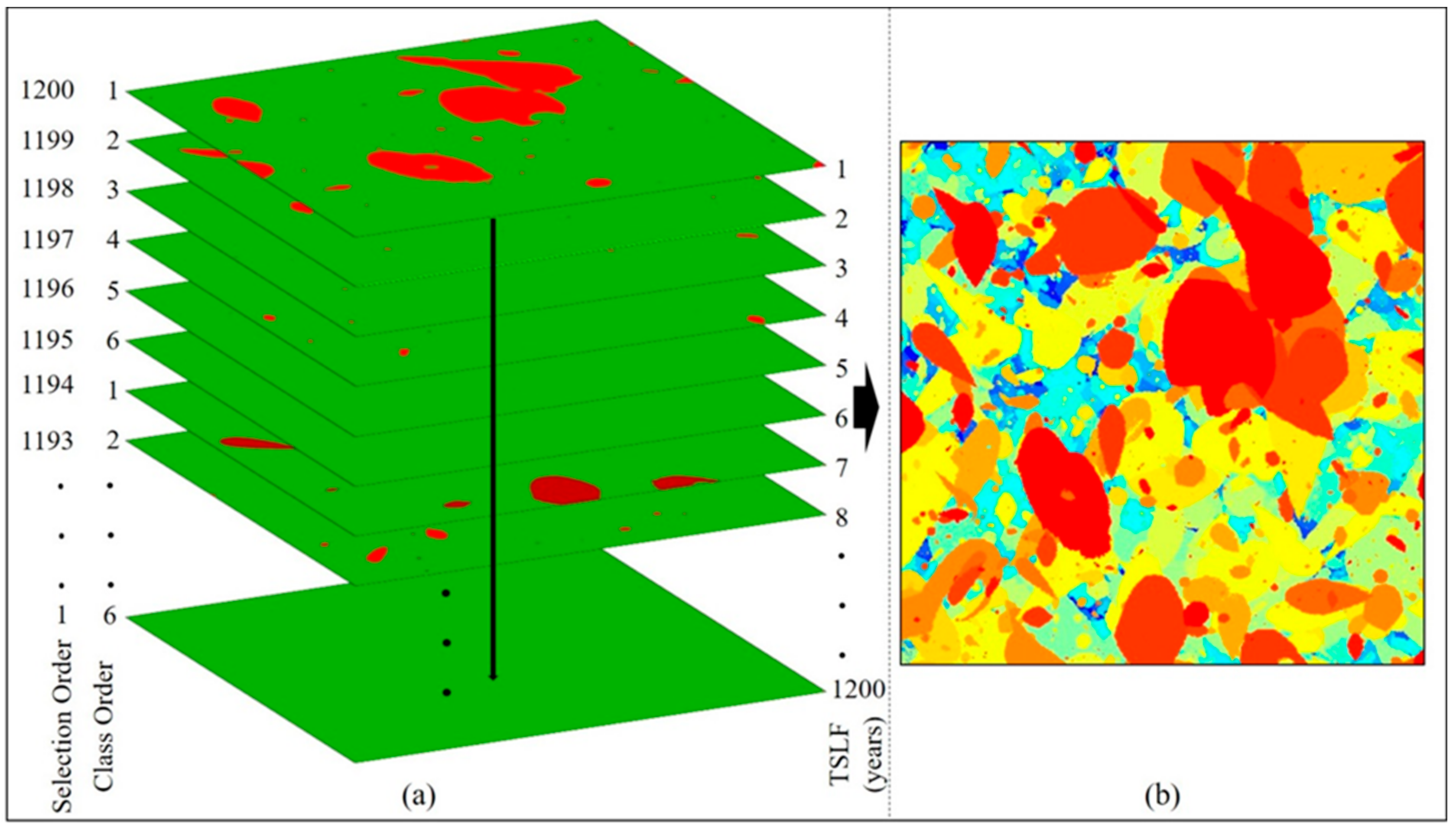

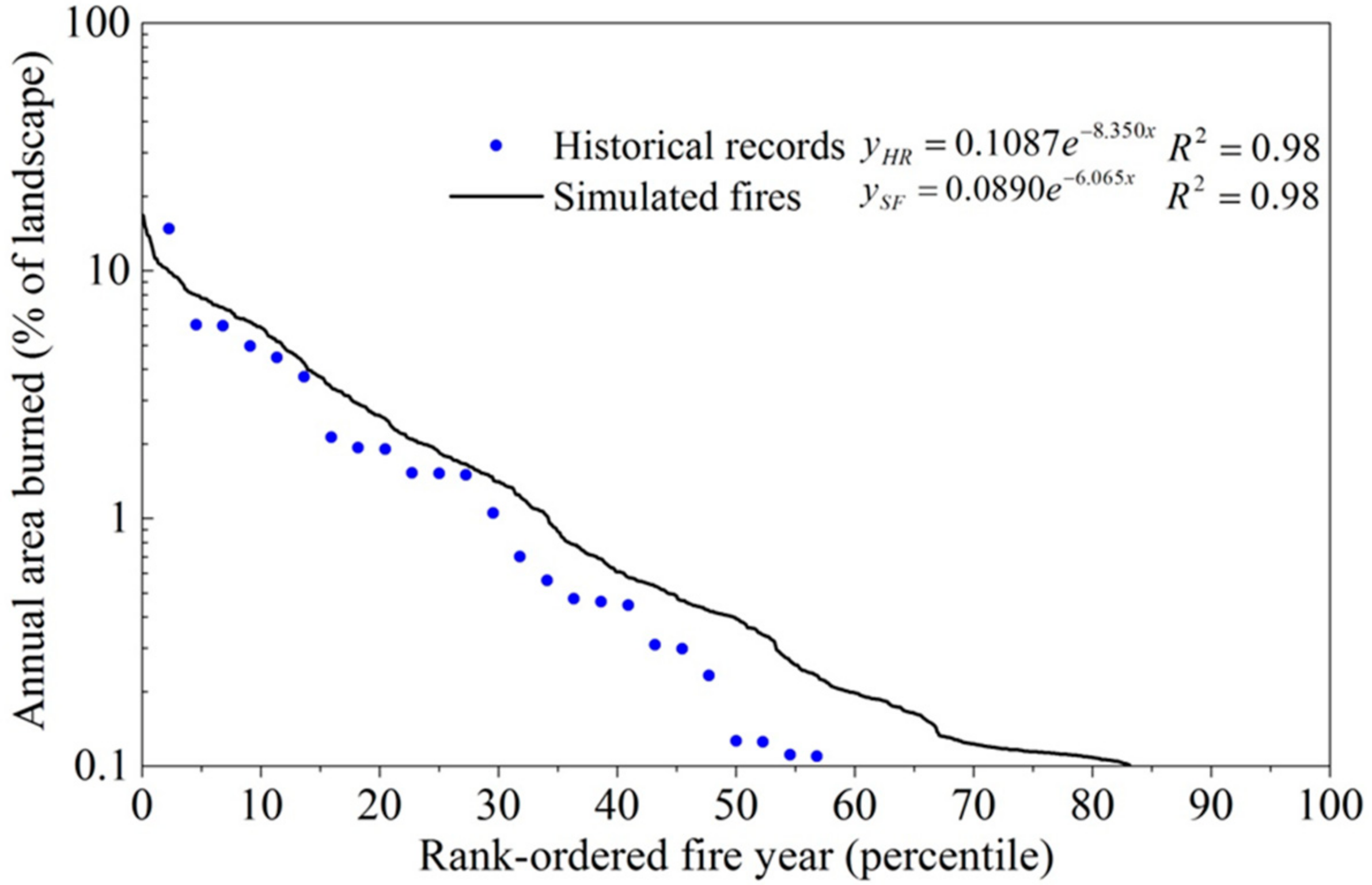
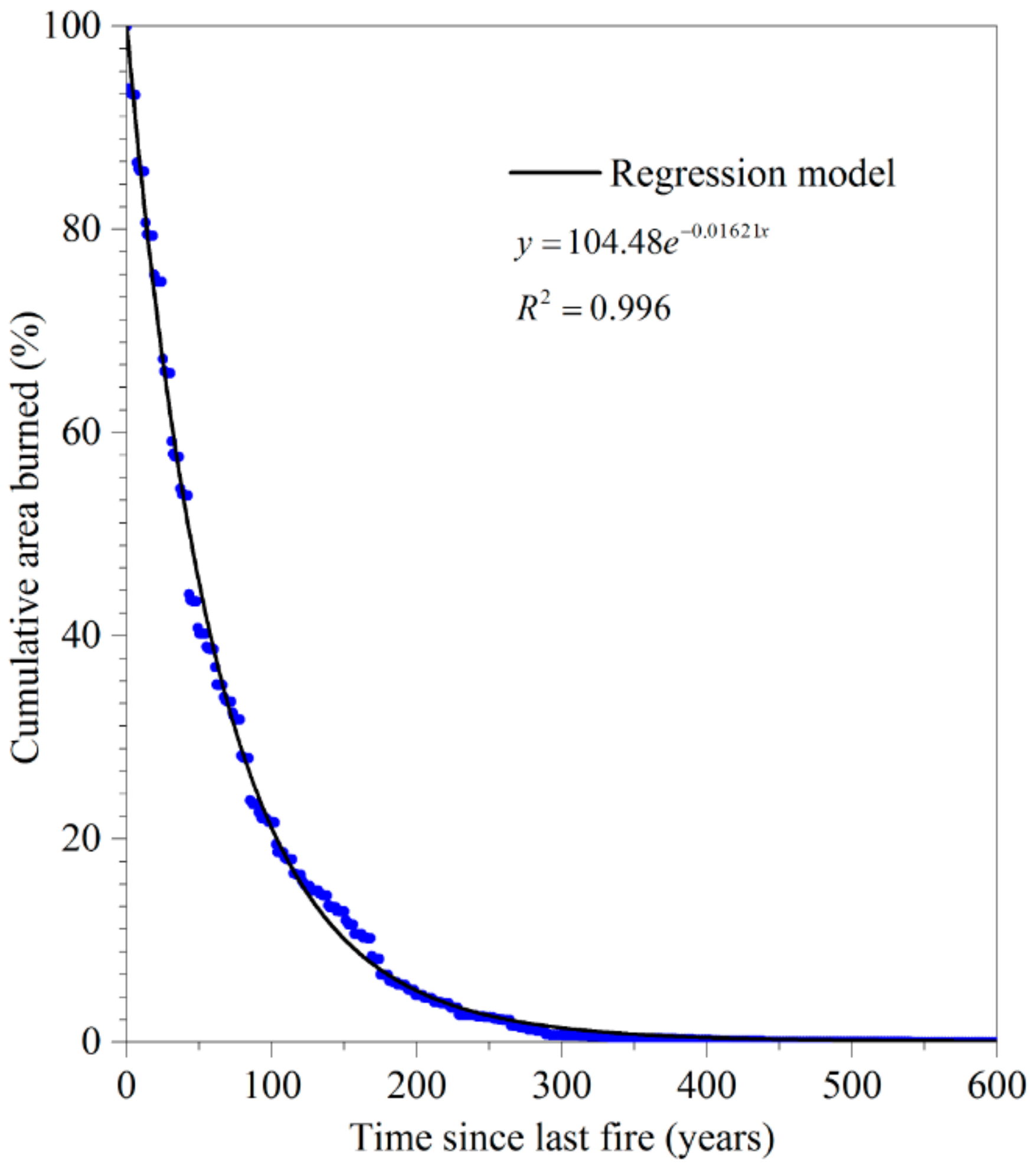
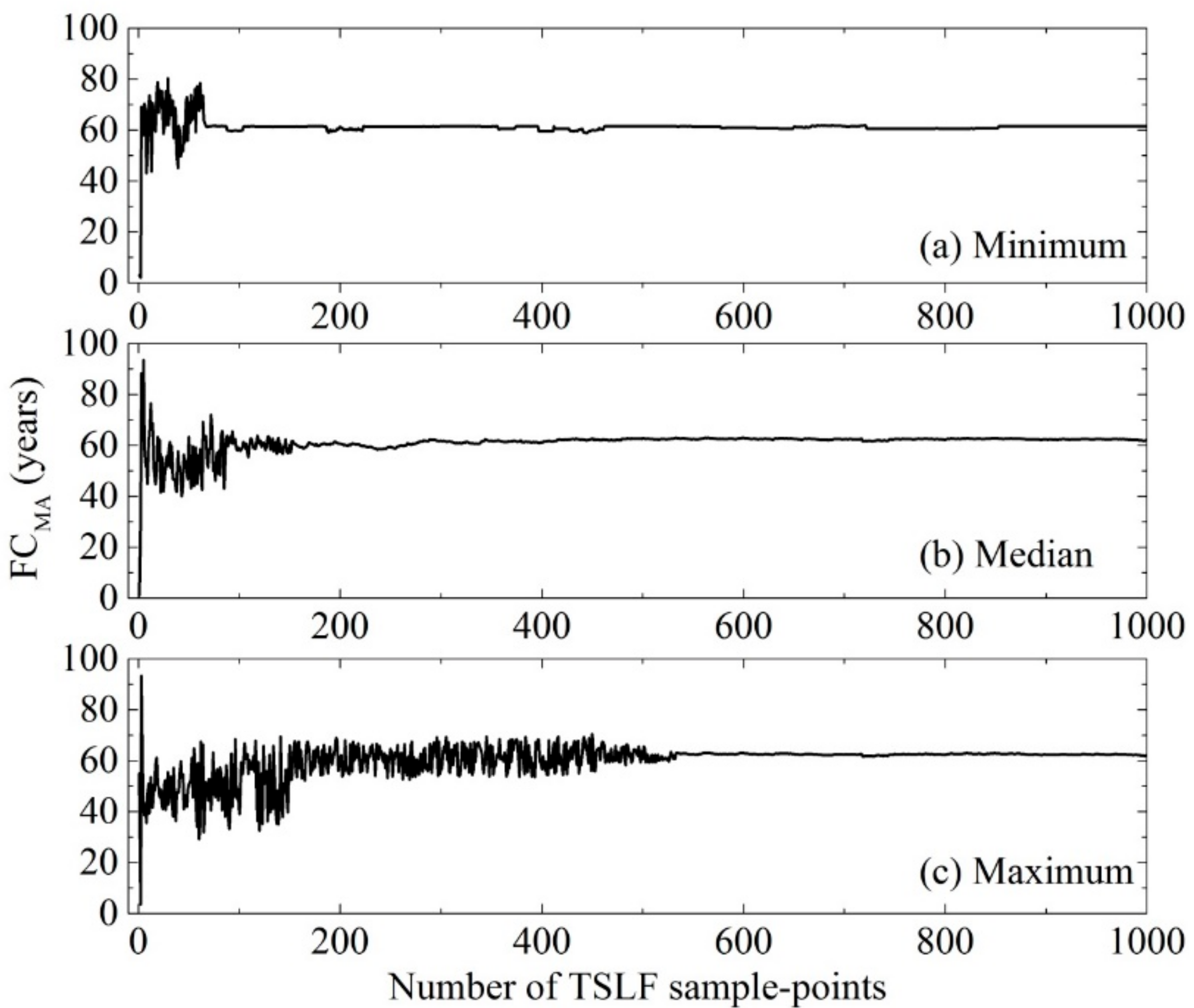
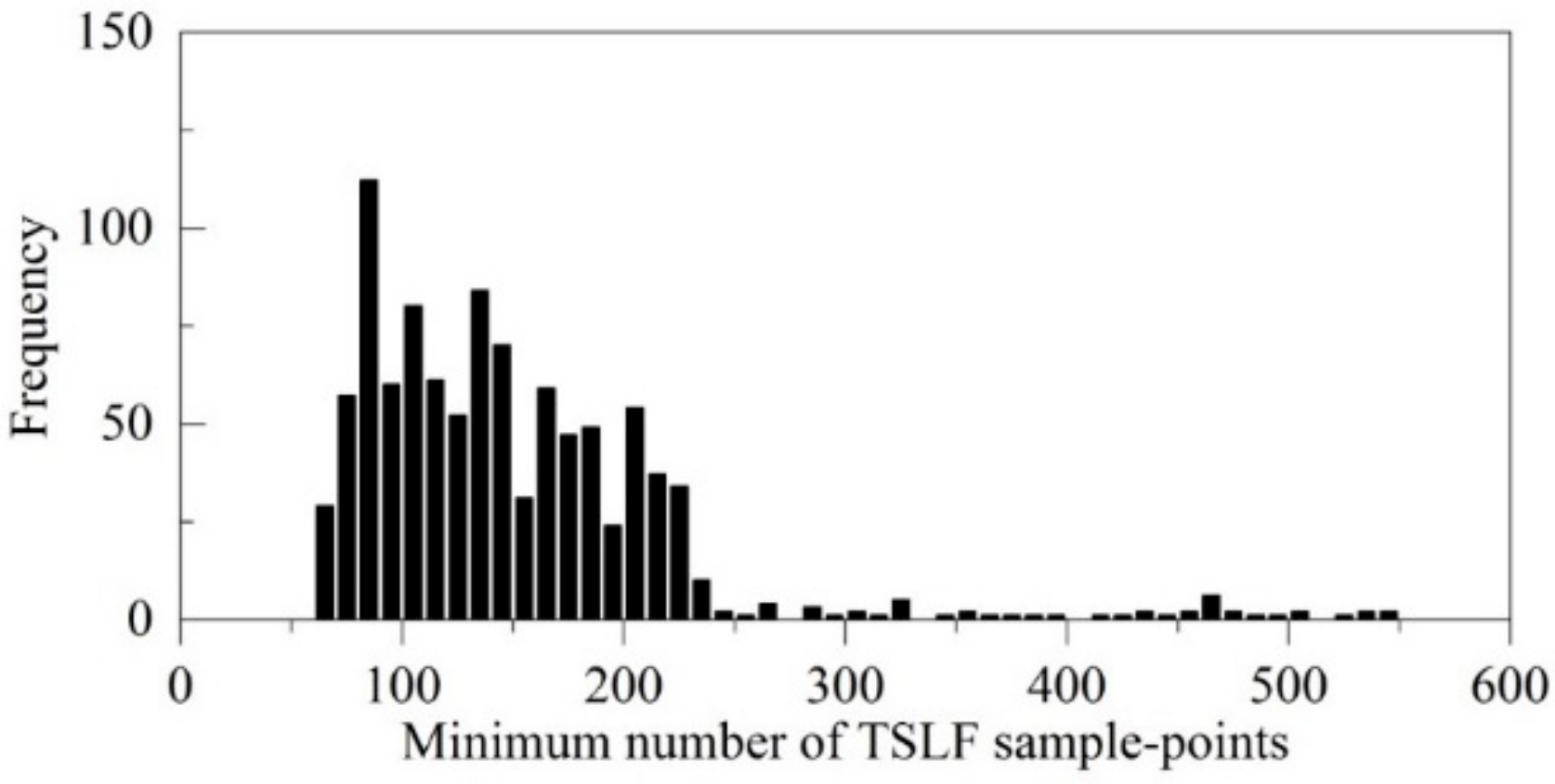
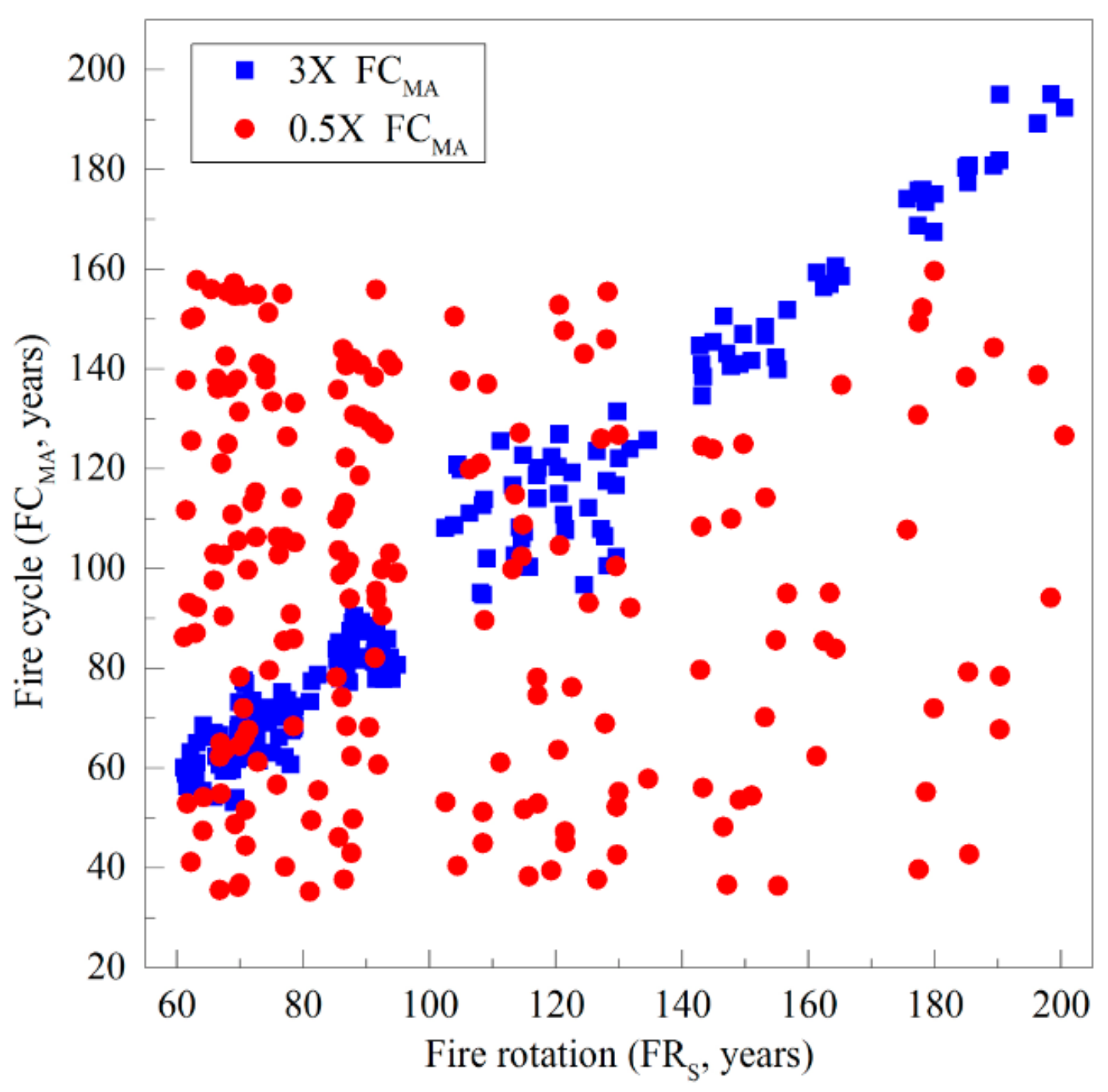
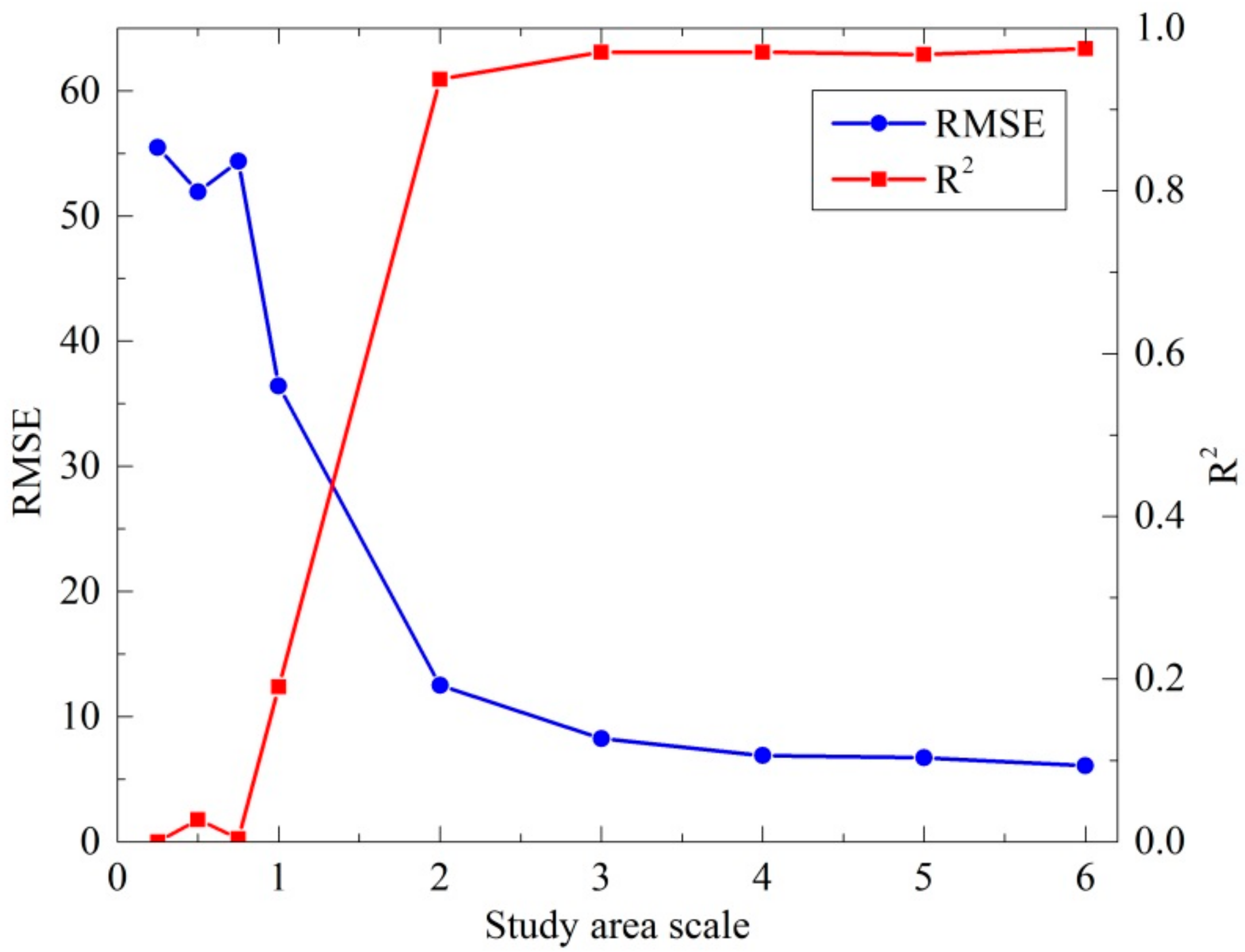
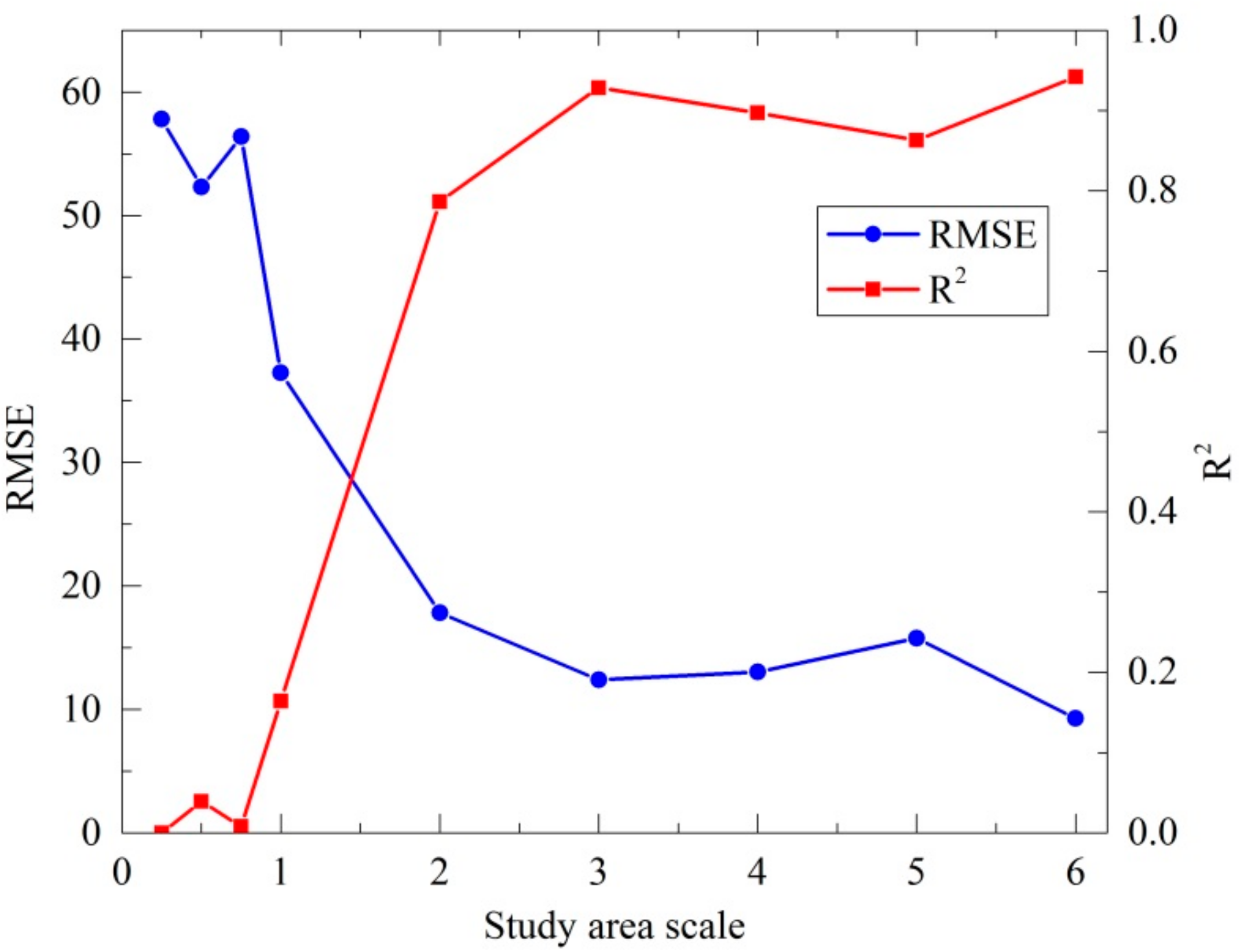
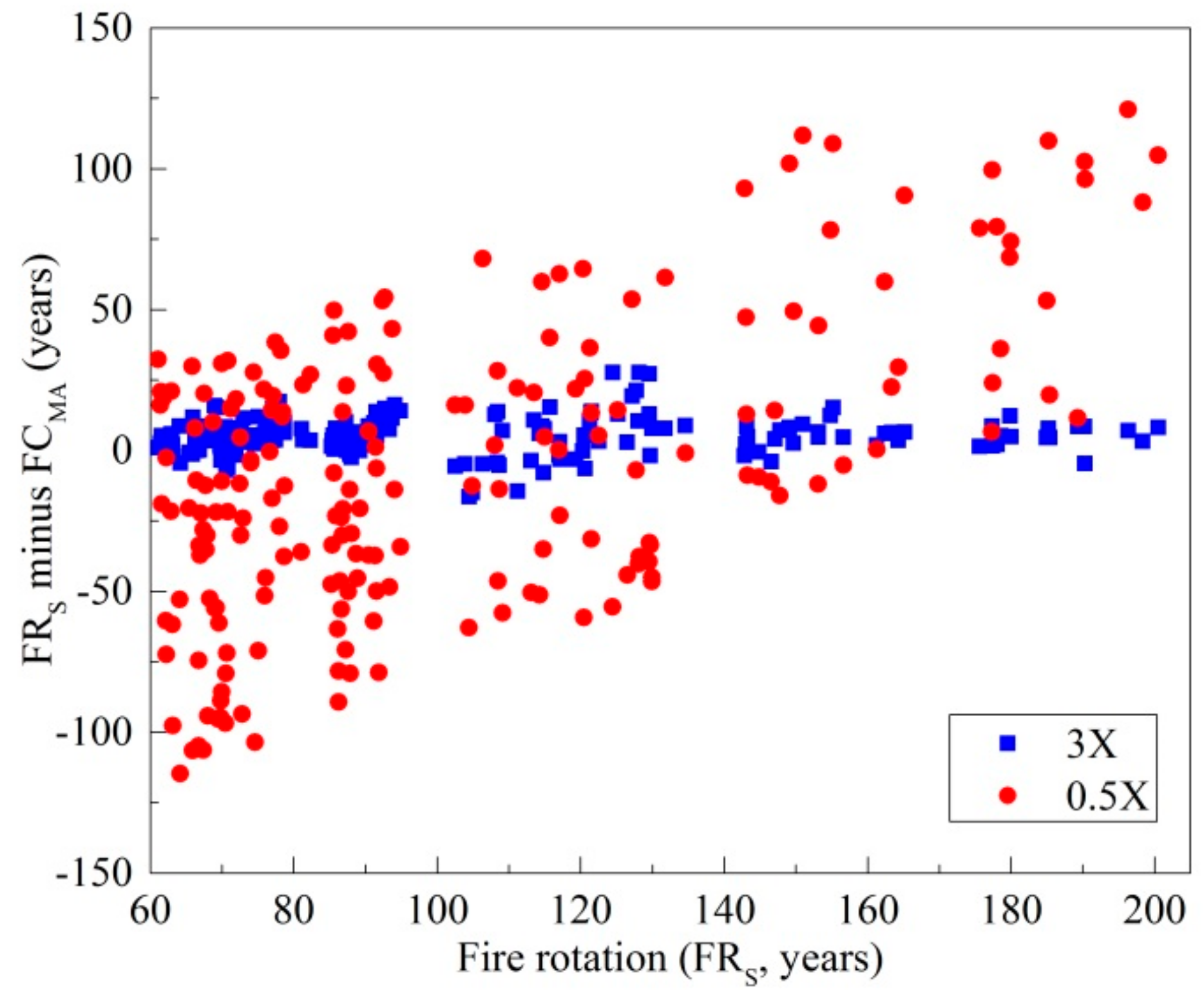
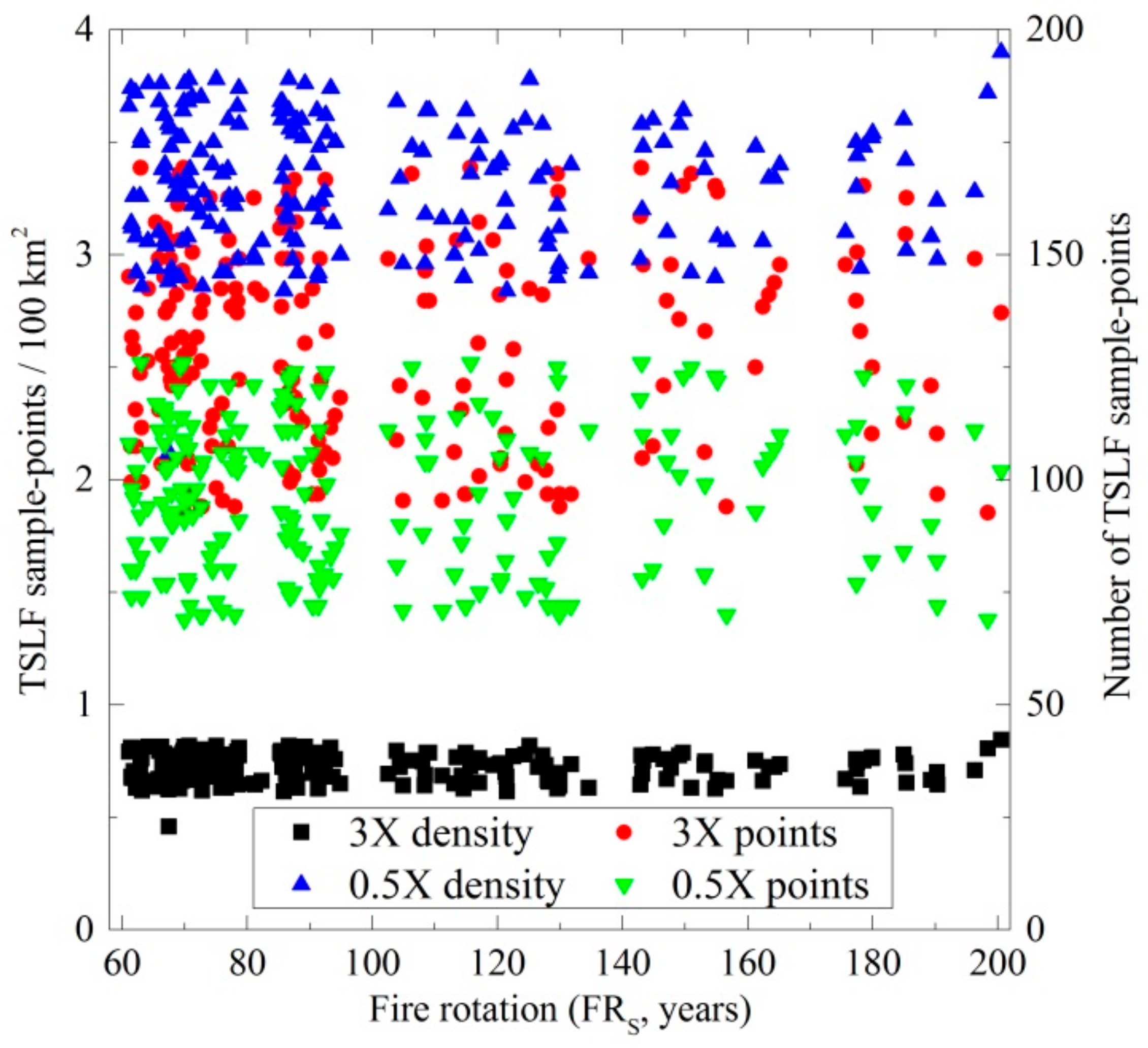

| Class of TAAB | TAAB Range (km2) | Historical Record of Fires (44 Years) | Simulated Fires (1200 Years) | ||||||
|---|---|---|---|---|---|---|---|---|---|
| LIF (km2) | SIF (km2) | MPLBA | PTA | LIF (km2) | SIF (km2) | MPLBA | PTA | ||
| 1 | >1000 | 1812.5 | 0.01 | 4.99 | 71.5 | 1562.3 | 0.01 | 6.56 | 68.6 |
| 2 | 400–999.9 | 847.9 | 0.01 | 1.65 | 20.7 | 732.6 | 0.01 | 2.24 | 21.4 |
| 3 | 100–399.9 | 193.5 | 0.01 | 0.47 | 6.2 | 180.6 | 0.01 | 0.63 | 6.0 |
| 4 | 10–99.9 | 48.1 | 0.01 | 0.07 | 1.4 | 45.2 | 0.01 | 0.23 | 2.8 |
| 5 | 1–9.9 | 6.3 | 0.01 | 0.01 | 0.2 | 6.0 | 0.01 | 0.10 | 1.2 |
| 6 | <1 | 0.4 | 0.01 | 0.00 | 0.0 | 0.0 | 0.00 | 0.00 | 0.0 |
| Class of TAAB | μ | σ | α (ha) | η |
|---|---|---|---|---|
| 1 | 5.02 | 3.65 | 181,248 | 108 |
| 2 | 3.70 | 3.20 | 84,790 | 84 |
| 3 | 3.01 | 2.74 | 19.352 | 78 |
| 4 | 2.61 | 2.16 | 4810 | 56 |
| 5 | 2.29 | 1.69 | 633 | 68 |
| 6 | - | - | 35 | 42 |
| Study Area Scale | Intercept | Slope | |||
|---|---|---|---|---|---|
| Constant | p-Value | Coefficient | p-Value | ||
| 6X | 0.002 | −0.038 | 0.980 | 0.0129 | 0.258 |
| 5X | 0.006 | −1.906 | 0.172 | 0.0192 | 0.133 |
| 4X | 0.002 | 1.505 | 0.261 | 0.0096 | 0.432 |
| 3X | 0.001 | 3.845 | 0.004 | 0.0134 | 0.273 |
| 2X | 0.260 | −5.921 | 0.001 | 0.1343 | 0.000 |
| 1X | 0.549 | −82.245 | 0.000 | 0.6954 | 0.000 |
| 0.75X | 0.529 | −103.17 | 0.000 | 1.0616 | 0.000 |
| 0.5X | 0.339 | −89.834 | 0.000 | 0.8114 | 0.000 |
| 0.25X | 0.448 | −104.66 | 0.000 | 1.0030 | 0.000 |
© 2018 by the authors. Licensee MDPI, Basel, Switzerland. This article is an open access article distributed under the terms and conditions of the Creative Commons Attribution (CC BY) license (http://creativecommons.org/licenses/by/4.0/).
Share and Cite
Wei, X.; Larsen, C.P.S. Assessing the Minimum Number of Time Since Last Fire Sample-Points Required to Estimate the Fire Cycle: Influences of Fire Rotation Length and Study Area Scale. Forests 2018, 9, 708. https://doi.org/10.3390/f9110708
Wei X, Larsen CPS. Assessing the Minimum Number of Time Since Last Fire Sample-Points Required to Estimate the Fire Cycle: Influences of Fire Rotation Length and Study Area Scale. Forests. 2018; 9(11):708. https://doi.org/10.3390/f9110708
Chicago/Turabian StyleWei, Xinyuan, and Chris P. S. Larsen. 2018. "Assessing the Minimum Number of Time Since Last Fire Sample-Points Required to Estimate the Fire Cycle: Influences of Fire Rotation Length and Study Area Scale" Forests 9, no. 11: 708. https://doi.org/10.3390/f9110708
APA StyleWei, X., & Larsen, C. P. S. (2018). Assessing the Minimum Number of Time Since Last Fire Sample-Points Required to Estimate the Fire Cycle: Influences of Fire Rotation Length and Study Area Scale. Forests, 9(11), 708. https://doi.org/10.3390/f9110708





